| |
VISUAL
REPORTS: "Last night, Feb. 24th, I was extremely
impressed by comet Lulin no matter what I used to observe it,"
reports Martin McKenna of Maghera, N. Ireland.
"With the naked eye I could see the comet as a large elliptical
5th mag haze 2 degrees below Saturn. Furthermore, using averted
vision I managed, just once, to glimpse the anti-tail without optical
aid as a fine streak pointing away from Saturn! The view of the
anti-tail in the 8.5" F/7 reflector with wide angle eyepiece
was absolutely
incredible. The anti-tail spike could be seen extending across
the entire field towards the Sun. It was extremely bright with well
defined edges and reminded me for all the world like a glorious
bright green blade or sword among the stars."
| |
Photographer,
Location |
Images |
Comments |
|
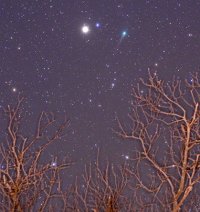
|
Doug Zubenel,
Linn County, Kansas.
Feb. 23, 2009 |
#1,
#2, #3,
#4 |
It was completely cloudy at sunset, and I had little hope of imaging Comet Lulin. At 9:00 pm, CST, the infrared satellite image showed a hole in the clouds over north-central Kansas moving SE and get larger, so I headed out to Linn County. By the time I was ready to shoot, all that remained were thin, high clouds that added just a touch of softness to the images, yielding aereoles around the bright stars and Saturn. In the last image, a faint corona can be seen around Saturn. Canon Rebel XTi with 50, 85, and 135mm lenses @ f/2.8, 2.8, and 4 respectively; exposures all 2 minutes at ISO 100.
|
|
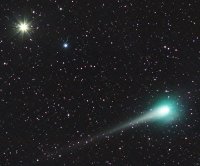
|
James Champagne,
Theriot, Louisiana, USA
Feb. 24, 2009 |
#1,
more |
Comet Lulin buzzed past Saturn on Tuesday morning. Equipment used included a Canon EF 200mm f/2.8L II Camera Lens at f/2.8 and Canon XTi piggybacked on a C8. Exposure was 30x60 sec @ ISO 1600.
|
|
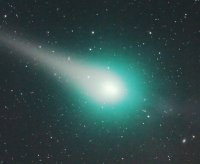
|
Conrad Pope,
Photographed from Kelly, NC
Feb. 23, 2009 |
#1,
more |
This is Comet Lulin around 11pm Feb 23, 2009. Photographed with a Tak FSQ refractor, using a Canon 5D MarkII, ISO 3200, 10, two minute exposures combined.
|
|
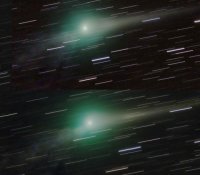
|
Tom J. Martinez,
Cleveland, Missouri, USA
Feb. 22, 2009 |
#1,
#2, more |
Comet Lulin's fantastic ion tail shows quite a difference from one hour to the next. An dark object below the ion tail is unusual. I'm not sure what this is (tail disconnect?). The bright star at lower left glows from the foggy gases of the ion tail. These were taken on the morning of the 22nd from the Midwest, using a Canon 300mm f/4 lens on a CCD-Labs Q543 camera. The 06:45 UTC image was 40, 1 minute exposures, the 08:00 UTC was 6, 10 minute exposures.
|
|
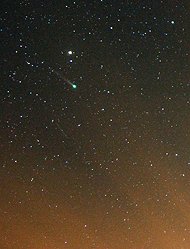
|
Becky Ramotowski,
Tijeras, New Mexico
Feb. 24, 2009 |
#1 |
The image above was a four minute shot. It looks like everything is racing into the Sun, but the simple reality was there were clouds illuminated by the skyglow of Albuquerque zooming past while I was out shooting the comet and Saturn early this morning so the movement made this crazy effect. Itís kinda cool donít you think? You can see all of Leo in this shot. Ceres is in this image as well, It's somewhere above Leo's tail.
ISO 400 Nikon D70 on Losmandy mount
F/4.5
24 mm lens
|
more
images:
from Ginger Mayfield
of Divide, Colorado; from
Tom Murdic of Franklin, TN; from
Francisco A. Rodriguez of Observatorio Montana Cabreja (Vega
de San Mateo, Gran Canaria - Canary Islands); from
Ari Koutsouradis of Westminster, MD; from
Jeff Greenwald of Laramie, Wyoming; from
Nicki Mennekens of Pingelly, Australia; from
Efrain Morales Rivera of Aguadilla, Puerto Rico; from
Ehsan Rostamizadeh of Kerman, Iran; from
Fredrik Broms of Kvaløya, Norway; |
|





